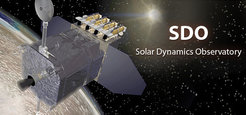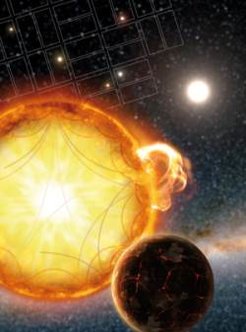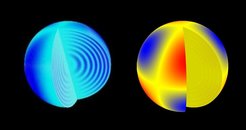Helioseismology and Asteroseismology
Helioseismology: A powerful tool in solar physics to study the interior of the Sun

Millions of modes of vibration, excited by solar convection, enable astrophysicists to see inside the Sun, just as geophysicists can probe the internal structure of the Earth thanks to earthquakes. Over the past twenty five years, helioseismology has produced a considerable number of discoveries in solar, stellar, and fundamental physics. Helioseismology has provided by far the most precise tests for the theory of stellar structure and evolution, implying, in particular, a revision of the standard model of particle physics to solve the solar neutrino problem. Today, the most exciting aspect of helioseismology is the search for clues regarding the origin and variability of the Sun’s magnetic field, possibly the most important unsolved problem in solar physics. The general belief is that the dynamo process, whereby magnetic field lines are stretched and twisted by internal shearing motions, causes the solar magnetic cycle. Helioseismology is our only hope to confirm this paradigm by mapping internal mass motions, structural asphericities, and their temporal variations. Thanks to helioseismic observations from the SOHO spacecraft (a very successful collaboration between ESA and NASA) since 1996 and the ground-based network GONG, helioseismology has already provided some important results, revealing regions of rotational shear in the Sun’s interior, solar-cycle variations in the rotation rate, and mysterious quasi-periodic changes at the base of the convection zone.
The next advances are expected to come from local helioseismology, which provides 3D views of the solar interior. Local helioseismology is based on the interpretation of the two-point correlations of the oscillations observed at the solar surface. Although still a developing science, it has already pinpointed a mechanism for the latitudinal transport of the magnetic flux that could determine the eleven-year period of the solar cycle. Detailed 3D maps of subsurface flows will be key to understanding the complex magnetohydrodynamical phenomena that control solar activity. In another application, local helioseismology can be used to detect active regions on the far side of the Sun, thus providing advance warning for harmful space weather events.

The launch in 2010 of SDO was an important technological step for helioseismology. With a high spatial resolution over the entire visible solar hemisphere, SDO enables us to follow the evolution of solar active regions as they rotate across the solar disk. Before the end of this decade, ESA’s Solar Orbiter will, for the first time, give access to the subsurface dynamics of the Sun’s polar regions.
In order to cope with the huge SDO data flow of the order of 1 TB/day, significant computing and storage resources were deployed at the MPS to set up a German Science Center for SDO ( GDC-SDO ). This major facility, supported by the German Aerospace Center (DLR) and the European Research Council (ERC), is operational today. Discoveries have been made concerning the subsurface structure of sunspots and the dynamics in the upper convection zone. Further advances will rely on new techniques of computational helioseismology, inspired from terrestrial seismology.
Instruments: SDO-HMI, GONG, SOHO-MDI
Asteroseismology: A tool in to probe the interiors of distant stars

Asteroseismology, the study of global oscillations on distant stars, is entering a very exciting period of discoveries. Many stars, covering a wide range of masses and evolutionary states, are known to exhibit oscillations. Much progress has been made in the last few years with the operation of the CoRoT satellite of CNES/ESA and the Kepler mission of NASA, which deliver excellent asteroseismic data for a few tens of Sunlike stars.
Stellar oscillations have considerable diagnostic potential and allow stellar mass and age to be determined with unprecedented precision. Such knowledge for a sufficient sample of stars will revolutionize stellar evolution and galactic evolution studies. Asteroseismology also has the potential to constrain internal stellar rotation and locate the borders of convection and ionization zones. Such information would help to understand dynamo-generated stellar activity cycles and the solar-stellar connection. These exciting possibilities for the study of stellar structure, evolution, and activity will be fully realized once high-precision observations become available for a large sample of stars.
The asteroseismology of planet-host stars will be particularly useful to characterize the properties of detected exoplanets. Precise seismic estimates of the masses, radii, and ages of host stars will make it possible to infer the masses, radii and ages of the transiting planets. The Kepler mission is a space based instrument launched in 2009 and is providing unprecendented observations of stellar oscillations. In an effort to efficiently exploit the data, the Kepler asteroseismic consortium exists to subdivide scientific goals amongst its members, including in the 'Solar and Stellar Interiors' department. Confirmed planetary systems will be fully characterized through the asteroseismology of their host stars and the follow-up observations. Observations of solar-like stars will also help to constrain our knowledge about the past and future life of the Sun.
Instruments: Kepler, CoRoT, SONG
Selected References: Probing the interior of Sun-like stars

[View] paper by Metcalfe, ..., Gizon, ..., Stahn et al. published in The Astrophysical Journal Letters (2012).
[ View] paper by Ballot, Gizon, ..., Stahn et al. published in Astronomy & Astrophysics (2011).
[ View] paper about measuring differential rotation with asteroseismology by Gizon and Solanki published in Solar Physics (2004).



